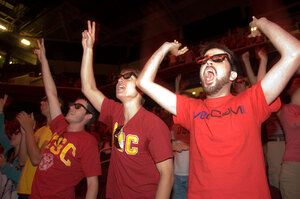Fans experience exhilarating win in 3-D
Thousands of people poured into the Galen Center on Saturday decked in Cardinal and Gold, but they weren’t going to see a USC basketball game.
Instead, the 7,500 people who attended the ESPN viewing this Saturday saw a historic college football game — in three dimensions.

Alternate viewing · Wearing special glasses, a few of the more than 7,000 fans cheer wildly at the Galen Center while watching USC’s nail-biting 18-15 win in a pilot three-dimensional telecast produced by ESPN. - Young Kim | Daily Trojan
With the Trojans in Columbus, Ohio, for their highly anticipated matchup with the No. 8 Ohio State Buckeyes, many faithful Trojan fans were looking for a way to experience the game without actually making the trip to Ohio Stadium. ESPN gave Trojans fans just that, as the Galen Center saw the first-ever broadcast of a college football game in RealD, which has been used in the past for movies such as Monsters vs. Aliens and the recent X-Games 3-D: The Movie.
The RealD experience is not what one might expect from a 3-D broadcast. Instead of images popping out of the screen, the feed — combined with special glasses which look much like the classic wayfarers of RayBan fame — create the illusion of depth, which provides a much more realistic viewing experience.
The Galen Center’s broadcast was not the only place to see the game in 3-D this weekend, as ESPN set up six other broadcast areas around the country, including the theater at L.A. Live.
The game experience seemed so realistic that fans might confuse the atmosphere for that of the Coliseum. The crowd shouted when the Buckeyes had the ball, and hushed when the Trojans drove on offense. They jeered whenever a Buckeye was even mentioned or shown on screen.
By halftime, with the score tied at 10, many were impressed by the 3-D viewing experience.
Jared Greiner, a junior majoring in interactive entertainment, was among those enjoying the broadcast enough to stay for the remainder of the game.
“It’s very cool, I’m glad I came,” Greiner said at halftime of the game. “I wasn’t planning on staying for the whole game, but I think I will now. As long as the game stays close.”
But Greiner, along with most of the crowd, was somewhat confused about how it all worked. Ed Cunningham, who joined Bob Davie and Mark Jones as the specialized broadcast team for the 3-D feed, had some explanation early in the first quarter.
“Two images are being pumped out into the [Galen Center], just like your eyes,” Cunningham said. “The game is shot at a little different angle than you’re used to seeing. It’s like a stop sign, from a distance it doesn’t look like it has much dimension, but as you get closer, there is more dimension to it.”
The crowd never seemed to care much for the real engineering behind the extravaganza, though. They only cared about the game.
As the game came down to the final minutes, the crowd was treated to the most realistic viewing experience they could have had without being at Ohio Stadium. When freshman quarterback Matt Barkley led the Trojans to the final scoring drive of the game, all of his passes were seen in three dimensions, as were all of junior Joe McKnight’s game-changing runs.
At the end of the night, the fans were asked to return their glasses in recycling bins to be reused, likely for one of the various 3-D movies that were previewed during commercial breaks. Because the game was so exhilirating, it was unclear how much the 3-D angles contributed to the fans’ post-game elation.
